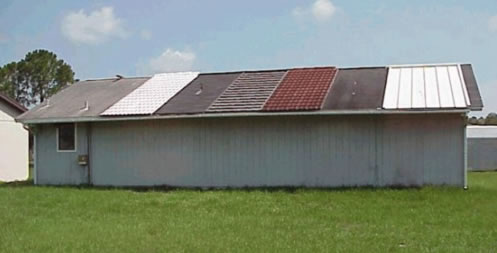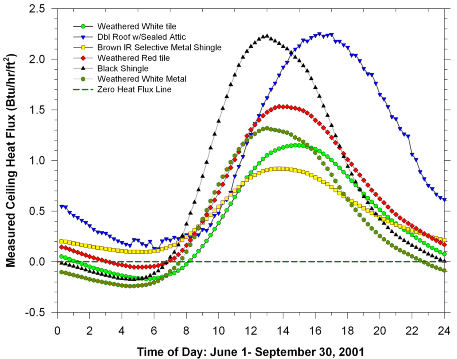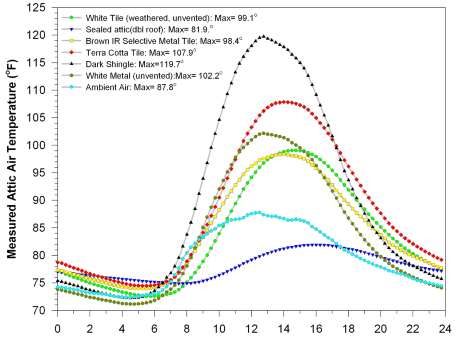| |
|
| |
| Reference
Publication:
Chandra, Subrato, Neil Moyer, Danny Parker, David Beal,
David Chasar, Eric Martin, Janet McIlvaine, Ross McCluney,
Andrew Gordon, Mike Lubliner, Mike McSorley, Ken Fonorow,
Mike Mullens, Mark McGinley, Stephanie Hutchinson, David
Hoak, and Linda Tozer. Building America Industrialized
Housing Partnership, Annual Report - Fourth Budget Period.
04/01/03-03/31/04. |
|
|
| Building
America Industrialized Housing Partnership, Annual
Report - Fourth Budget Period |
|
|
Subrato
Chandra, Neil
Moyer, Danny
Parker, David
Beal, David
Chasar, Eric
Martin, Janet
McIlvaine, Ross
McCluney, Andrew
Gordon, Mike
Lubliner, Mike McSorley, Ken
Fonorow, Mike
Mullens, Mark
McGinley, Stephanie
Hutchinson, David
Hoak, and Linda Tozer |
|
| Florida
Solar Energy Center |
|
| |
|
In
the 2001 testing, Cell #2 with the double roof/sealed attic
showed the lowest attic temperatures and narrowest temperature
range. (Please see Table 27, and Figures 71, and 73.)
Peak attic temperatures in Cell #2 were 5oF to
6oF lower than this same sealed cell the year
before, without the double roof. This indicates that the
double roof did provide a substantial benefit. Since there
is no insulation on the attic floor though, there still
is a significant heat gain across the ceiling. In fact,
the ceiling heat fluctuation actually is higher than the
reference Cell #5. (Please see Figure 72.)
The
true impact of the double roof construction of Cell #2 is
most likely a combination of the benefits of a cooler attic
space that reduces duct heat gain and minimizes the effects
of air leakage from the attic into the house, and the drawback
of the higher ceiling heat flux.
Cell
#3 with its spectrally selective dark brown metal shingles,
produced lower attic temperatures at night, but higher roof
deck temperatures (which were most likely due to the insulating
quality of the shingles which have an air space underneath
them).
| Cell
# |
Roof
Material |
Venti-
lation |
Avg
Attic Temp |
Max
Attic Temp |
| #1 |
white
tile (weathered) |
sealed |
84.6 |
111.2 |
| #2 |
double
roof with radiant barrier (ins roof deck) |
sealed |
78.4 |
85.4 |
| #3 |
brown
IR selective metal shingle |
vented |
85.0 |
110.8 |
| #4 |
terra
cotta tile (weathered) |
vented |
89.0 |
124.3 |
| #5 |
dark
shingles (control) |
vented |
91.0 |
143.4 |
| #6 |
white
standing seam metal (weathered) |
sealed |
84.0 |
115.5 |
Table
27. 2001 roof cell configurations.
 |
Figure 71.
2001 Experimental roof cell. Cell #1 is located
on the left, and
Cell #6 on the far right. |
 |
Figure
72. 2001 heat flux measurements across attic. |
 |
Figure
73. 2001 mid-attic temperatures. |
Habitat
Homes - Fort Myers, Florida: In July 2000, FSEC and
Florida Power and Light instrumented six side-by-side Habitat
for Humanity homes in Ft. Myers with identical floor plans,
orientation ,and ceiling insulation, but with different
roofing systems. A seventh monitored house contained an
unvented attic with insulation on the underside of the roof
deck rather than on the ceiling.
An
evaluation of roof and attic thermal performance clearly
showed the energy-saving benefits of reflective roofing
systems in Florida. Tested roofs with high solar reflectance
offered impressive air conditioning energy savings, especially
the tile and metal roofs with a solar reflectance between
65% and 75%. (Please see Table 28.)
| (RGS)
Standard dark shingles (control) |
(RTB)
Terra cotta S-tile roof |
|
(RWS) Light colored shingles |
(RWB)
White "barrel" S-tile roof |
| (RSL)
Standard dark shingles with sealed |
(RWF)
White flat tile roof |
| attic
& R-19 roof deck insulation |
(RWM)
White metal roof |
| Site |
Total
kWh |
Savings
kWh |
Saved
Percent |
Demand
kW |
Savings
kW |
Saved
Percent |
| RGS |
17.03 |
---- |
---- |
1.63 |
---- |
---- |
| RWS |
15.29 |
1.74 |
10.2% |
1.44 |
0.19 |
11.80% |
| RSL |
14.73 |
2.30 |
13.05% |
1.63 |
0.01 |
0.30% |
| RTB |
16.02 |
1.01 |
5.9% |
1.57 |
0.06 |
3.70% |
| RWB |
13.32 |
3.71 |
21.8% |
1.07 |
0.56 |
34.20% |
| RWF |
13.20 |
3.83 |
22.5% |
1.02 |
0.61 |
37.50% |
| RWM |
12.03 |
5.00 |
29.4% |
0.98 |
0.65 |
39.70% |
Table
28. Each unoccupied home was monitored simultaneously
from
July
8 through July 31, 2001 to collect building thermal and
air conditioning power data. This table presents the
cooling performance of the roofing systems of these unoccupied
homes.
Significant
findings: Reflective roofing materials represent one of
the most significant energy-saving options available to
homeowners and builders. These materials also reduce cooling
demand during utility coincident peak periods, and are potentially
one of the most effective methods for controlling demand.
- Based
on comparative data from August of 2000, the maximum decking
temperatures in the sealed attic home were 23EF higher than
the control home (177E versus 154E). After the installation
of white shingles in midsummer, the highest deck temperature
from the sealed attic home measured only 7E higher than
the control in August of 2001 (161E versus 154E).
-
An
additional month's data was collected with the homes occupied
and thermostat set points kept constant. Average cooling
energy use for the homes rose by 36%, but there was no
decrease in the highly reflective roofing system savings.
Additional heat gained from the occupants and their appliance
use increased the cooling system runtime and introduced
more hot air into the air conditioning duct system.
-
In
2001, the average maximum attic air temperature in the
terra cotta barrel tile roof home was 15EF hotter than
the maximum ambient. After installing a radiant barrier
the average difference in August was +9EF. A similar
evaluation with the light colored shingles showed that
peak attic air temperatures dropped from + 29E to +20EF
after installing a radiant barrier.
-
Household
interior temperature settings varied from one year to
the next, making direct energy saving comparisons impossible.
Still, the collected data did show that attic air temperatures
were reduced by the radiant barrier. On the other hand,
measured maximum plywood decking temperatures rose by
11E to 13EF.
-
Based
on previously evaluated roof buckling problems on the
decking of the sealed attic home, researchers decided
to install white shingles similar to those on the RWS
roof. It was thought that buckling problems likely were
caused by excessive heat buildup in this roofing system.
White shingles replaced the dark shingles to see if this
would drop the roof decking temperature spikes.
|
Disclaimer:
This report was prepared as an account of work sponsored by an agency
of the United States government. Neither the United States government
nor any agency thereof, nor any of their employees, makes any
warranty, express or implied, or assumes any legal liability
or responsibility for the accuracy, completeness, or usefulness
of any information, apparatus, product, or process disclosed,
or represents that its use would not infringe privately owned
rights. Reference herein to any specific commercial product,
process, or service by trade name, trademark, manufacturer,
or otherwise does not necessarily constitute or imply its endorsement,
recommendation, or favoring by the United States government
or any agency thereof. The views and opinions of authors expressed
herein do not necessarily state or reflect those of the United
States government or any agency thereof.
|






